What makes a villain a villain? I’ve always been a fascinated—and a little bit terrified—of villains, especially in fairytales. As a child, I couldn’t get enough of Snow White and the Seven Dwarfs even if the old witch sent me diving into our couch cushions to hide my eyes.
Add a CommentViewing: Blog Posts Tagged with: writing resources, Most Recent at Top [Help]
Results 26 - 50 of 192
Blog: The Children's Book Review (Login to Add to MyJacketFlap)
JacketFlap tags: Fantasy: Supernatural Fiction, Writing Resources, Ages 9-12, Fairy Tales, Chapter Books, Fractured Fairy Tales, Character Development, Jen Calonita, Villians, Add a tag
Blog: The Children's Book Review (Login to Add to MyJacketFlap)
JacketFlap tags: Writing Resources, Screenwriting, Teens: Young Adults, Lex Thomas, Quarantine series, Add a tag
A screenplay is a blueprint for a story to be carried out in another medium, by a bunch of other artists. A novel is a finished work, and it’s all yours.
Add a CommentBlog: The Children's Book Review (Login to Add to MyJacketFlap)
JacketFlap tags: Emily Raabe, Writing Resources, Ages 9-12, Chapter Books, Book Tours, Knopf Books for Young Readers, Add a tag
When I published my first novel in April, I knew that a) I wanted to go on a book tour, and b) New authors, with a few exceptions, don't get book tours anymore.
Add a CommentBlog: The Open Book (Login to Add to MyJacketFlap)
JacketFlap tags: science fiction, writing tips, writing advice, writing resources, Science Fiction/Fantasy, worldbuilding, fantasy writing, Writer Resources, young adult writing, Publishing 101, stacy whitman, Tu Books, Add a tag
 Stacy Whitman is Editorial Director and Publisher of Tu Books, an imprint of LEE & LOW BOOKS that publishes diverse science fiction and fantasy for middle grade and young adult readers. Parts of this blog post were originally posted at her blog, Stacy Whitman’s Grimoire.
Stacy Whitman is Editorial Director and Publisher of Tu Books, an imprint of LEE & LOW BOOKS that publishes diverse science fiction and fantasy for middle grade and young adult readers. Parts of this blog post were originally posted at her blog, Stacy Whitman’s Grimoire.
Last week, I discussed why worldbuilding in speculative fiction can be so challenging for authors. How do we introduce a completely new world without infodumping or confusing readers? I gave some examples of worldbuilding done well in popular YA science fiction and fantasy: The Hunger Games, Divergent, and Twilight. In all these cases, the starting point is in some way relatable, or there is something about the character (Tris, Katniss) that hooks the reader. First pages should be character- and plot-driven, and worldbuilding should support rather than dominate. That gives these books an easy entry point and wide appeal.
There are three primary approaches to worldbuilding:
Reader learns world alongside character
Readers of Harry Potter, Percy Jackson, and Twilight figure out the world alongside the main character. Information is spooled out as the character learns it, so the reader doesn’t have to absorb everything at once. This is a low bar for entry, not requiring much synthesis of information. The character is almost a stand-in for the reader.
Exposition: questions raised, then answered
What about Hunger Games? Now it gets a little tougher. Suzanne Collins starts out with a perfectly relatable (if a tiny bit cliche) situation, the main character waking up and seeing her family. We get some exposition on Katniss’s family and the cat who hates her.
But it becomes non-cliche by page 2, when we learn about the Reaping. Ah! What’s the Reaping, you ask? We don’t know yet. Now the bar for entry is raised. There is a question, the answer for which you’re going to have to read further to find out. The infodumpage level is low, but there is still some exposition in the next few pages, letting us know that Katniss lives in a place called District 12, nicknamed the Seam, and that her town is enclosed by a fence that is sometimes electrified—and which is supposed to be electrified all the time.
Collins’s approach to spooling out a little information at a time is to explain each new term as she goes, but some readers think that feels unnatural in a first person voice because the narrator would already know these things, so why is she explaining them to the reader?
It depends on the story, in my opinion—Collins makes it work because of how she crafted Katniss’s voice. It is a very fine line to walk—I can’t tell you how many submissions I’ve received that start out with, “My name is X. I am Y years old. I live in a world that does Z,” an obvious example of how this approach becomes downright clumsy when not handled with Collins-esque finesse.
“Incluing”: questions raised, then reader infers answers bit by bit
Then there is the opposite end of the spectrum, in which the reader is given clues to work out rather than having any new terms explained to them. This approach needs just as much, if not more, finesse. It’s a process that some readers who are new to speculative fiction might stumble over the most, which is why I think there’s so little of it in middle grade and YA fantasy and science fiction. I’ve seen it called “incluing,” which is a silly word, but I don’t know of another name for it and the description of incluing in that Wikipedia link is exactly the kind of worldbuilding I—as a lifelong fantasy fan—prefer to see in the beginning of a book, particularly one set in a world that has no connection to our own, or if it’s in the future of our world far enough into the future that the society is unrecognizable to us, such as the society in Tankborn. Karen Sandler does a wonderful job at incluing readers as we read chapter 1 of the first book in the Tankborn trilogy.
The prominent example I like to give writers for this kind of worldbuilding is from The Golden Compass. Check out the first paragraph of that book:
“Lyra and her daemon moved through the darkening hall, taking care to keep to one side, out of sight of the kitchen. The three great tables that ran the length of the hall were laid already, the silver and the glass catching what little light there was, and the long benches were pulled out ready for the guests. Portraits of former Masters hung high up in the gloom along the walls. Lyra reached the dais and looked back at the open kitchen door, and, seeing no one, stepped up beside the high table.”
Pullman jumps right into the scene, with Lyra sneaking down the dining hall with her daemon. We’re hooked—she’s doing something sneaky, and we don’t know what. And we want to know. We don’t even know what the daemon physically looks like until paragraph 4, and even then we don’t know why he’s called a daemon or what makes a daemon special.
What is a daemon, anyway? We don’t know! In fact, this is one of the major conflicts of the book—we need to read more to find out about daemons, and further mysteries are revealed as we read that deepen our understanding of daemons and of Lyra’s world in general. As we discover more clues that intrigue us, we want to know more, and keep reading.
But the line between intriguing the reader and confusing the reader is very thin, and I would argue that for some readers it’s in a different place than for others. Those of us who are familiar with fantasy might be more willing to patiently wait for more information about daemons because we trust that this author will let us know what we need to know when the time is right. We know that they’re teasing us with this information so as not to overburden us within the first few pages of the book (or, in the case of The Golden Compass, because the reader can’t know what the majority of people in that world don’t know, either).
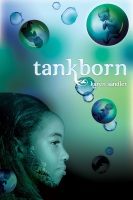 In situations in which you need to establish a world that’s entirely different from our own, I find that putting a character in a situation that’s somewhat familiar to the reader can help with establishing the unfamiliar. In Karen Sandler’s Tankborn, for example, Kayla has to watch her little brother instead of going to a street fair with her friends. While Kayla calls him her “nurture brother” instead of just her brother, it’s still a situation to which a lot of readers can relate, even if it is set on another planet and her brother is catching nasty arachnid-based sewer toads instead of familiar Earth frogs and toads.
In situations in which you need to establish a world that’s entirely different from our own, I find that putting a character in a situation that’s somewhat familiar to the reader can help with establishing the unfamiliar. In Karen Sandler’s Tankborn, for example, Kayla has to watch her little brother instead of going to a street fair with her friends. While Kayla calls him her “nurture brother” instead of just her brother, it’s still a situation to which a lot of readers can relate, even if it is set on another planet and her brother is catching nasty arachnid-based sewer toads instead of familiar Earth frogs and toads.
M. K. Hutchins, author of Drift, approached it in a completely different way. She starts with a dangerous situation—a family on the run from authorities, splitting up. The mother, our main character Tenjat, and his sister Eflet are embarking on a terrible journey that’s almost certain death, setting off on a raft in the middle of the night into an ocean full of snake-like monsters, and leaving the family’s father and smallest brother behind to face unknown punishment. While perhaps no reader has been chased by authorities in the middle of the night, it is a dangerous situation and a parting of family—mixing the familiar (family) with the unfamiliar (a dangerous situation in a completely new setting).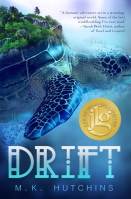
It’s the difference between showing and telling. Philip Pullman, Karen Sandler, and M. K. Hutchins all show us how their worlds works, rather than pausing to tell us how it works (“in this world, all people are born with an animal companion called a daemon”).
Telling can work, though, especially in small doses—Katniss’s voice is so conversational that the brief moments of telling in the first few pages of The Hunger Games work, particularly because Collins is mostly showing what Katniss is up to. The brief pauses to “infodump” feel like the reader is being told a story by a storyteller, like a friend telling a story over the kitchen table after a nice big meal would pause and explain something you didn’t understand (a friend who’s a very good storyteller). It’s an awareness of audience that most speculative fiction doesn’t have the luxury of.
Showing isn’t always better, and telling isn’t always bad, when done right and mixed in with showing. Whichever method you use, remember that sometimes readers will trip over new words so you need to give them as much context as possible without over-infodumping.
And here is where the art comes in. I can’t tell you what that balance is, but if you look at examples like the ones above, you’ll get a better feel for how much to reveal and how much to hold back in your first few pages—revealing enough to orient your reader and give them a sense of the differences of this world (while grounding them in something familiar like Lyra’s hallway or Katniss’s humble home) while seeking to avoid overburdening them with too much all at once.
What about you? How have you found the right balance of introducing your world without overburdening the reader? What books do you recommend that do this particularly well?
Filed under: Publishing 101, Tu Books, Writer Resources Tagged: fantasy writing, science fiction, Science Fiction/Fantasy, stacy whitman, Tu Books, worldbuilding, writing advice, writing resources, writing tips, young adult writing
Blog: The Open Book (Login to Add to MyJacketFlap)
JacketFlap tags: science fiction, writing tips, writing advice, writing resources, Science Fiction/Fantasy, worldbuilding, fantasy writing, Writer Resources, young adult writing, Publishing 101, stacy whitman, Add a tag
Stacy Whitman is Editorial Director and Publisher of Tu Books, an imprint of LEE & LOW BOOKS that publishes diverse science fiction and fantasy for middle grade and young adult readers. Parts of this blog post were originally posted at her blog, Stacy Whitman’s Grimoire.
During the first week of June, I attended the Asian Festival of Children’s Content in Singapore. At the conference, I met writers from all over Asia and the Pacific, discussing craft, marketing their books at home and abroad, and translation. I even ran into Mark Greenwood and Frané Lessac, the Australian author/illustrator team behind the LEE & LOW picture book The Drummer Boy of John John. I enjoyed all the panels and the chance to see Singapore and meet so many people from the other side of the world—it gives you a perspective as an editor you might not otherwise have.
One of the panels I participated in was a First Pages event, in which I read about 20 first pages of picture books, middle grade, and YA novels and then gave feedback on whether the pages were working for me and if I’d want to read more.
For the fantasy and science fiction entries, a common problem was—and is in any new writer’s writing—revealing enough about the world that you create interest and intrigue, but not too much. Too much, and you risk alienating your audience, confusing them, or simply not hooking them. Reader reactions are so subjective. One person might think there’s not nearly enough worldbuilding in a book (“give me more! MORE!”) and another might say of the exact same book that what worldbuilding there is was way too confusing (“I couldn’t keep all those made-up words straight!”).
So how do you, as the author, balance the needs of such a wide range of readers when you’re working in a complex world? And how do you balance the need to establish your characters, setting, and plot with the need to spool out information to your reader to intrigue them rather than confuse them?
This is a question that almost every author and editor of speculative fiction struggles with, particularly because we, as veterans of the genre, are already more comfortable with a lot of jargon than your average teen reader, particularly teen readers whose preference for fantasy runs more toward the contemporary paranormal variety.
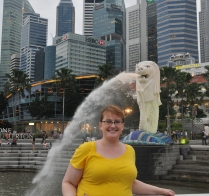
Stacy Whitman at the famous Singapore merlion fountain
There are a number of reasons why I think Twilight was so popular on such a broad scale, but one of the biggest ones was the relatability of the initial situation. Not vampires showing up at school—before that. We start with a simple story about a girl who is leaving her mother behind in Arizona to live with her father in an unknown small town on the Olympic Peninsula of Washington. Relatable: divorced parents, fish out of water, adapting to a new school and a new climate.
Think about all the really big fantasy hits of the last decade or so in children’s and YA fiction: Harry Potter, Percy Jackson, Twilight, Hunger Games, Divergent. Of these books’ beginnings, only the dystopian tales start all that far outside the everyday experiences of your average young reader, and even The Hunger Games starts with a relatable situation—a coal mining family lives in a desperate situation and must hunt for food.
While most kids who would have access to The Hunger Games don’t live under a despotic regime, it’s plausible that it could happen in the real world. Every kid has been hungry at some point, though perhaps not as hungry and desperate as Katniss. Every kid has taken a test in school, and sometimes it feels like those standardized tests do determine your everlasting fate, as they do in Divergent, even if Tris’s Abnegation explanations are a little tedious. Harry Potter and Percy Jackson are ordinary kids going to school, living somewhat normal lives (even if abusive ones, in the case of Harry) before their worlds change with the discovery of magic.
There are three primary approaches to worldbuilding:
Reader learns world alongside character
Exposition: questions raised, then answered
“Incluing”: questions raised, then reader infers answers bit by bit
Next Thursday, I’ll go into detail about each of these techniques and give some examples. In the meantime, think about your favorite science fiction and fantasy books. How do they bring you into their world? What works best for you as a reader? Answering these questions about your own reading preferences can help guide you as a writer.
Filed under: Publishing 101, Writer Resources Tagged: fantasy writing, science fiction, Science Fiction/Fantasy, stacy whitman, worldbuilding, writing advice, writing resources, writing tips, young adult writing
Blog: The Children's Book Review (Login to Add to MyJacketFlap)
JacketFlap tags: Mysteries, Writing Resources, Chapter Books, Paranormal, YA Books, featured, Thrillers, Books for Girls, Fantasy: Supernatural Fiction, Teens: Young Adults, Sasha Dawn, Add a tag
If I were to write this tale, I’d have to research hauntings, of course, and children who grow up with surrogate parents, and anxiety issues and medications. Assuming I’m comfortable gathering this information, there are few things I’ll look at to see if I have the makings of a YA psychological, suspenseful thriller:
Add a CommentBlog: The Children's Book Review (Login to Add to MyJacketFlap)
JacketFlap tags: Health, Writing Resources, Ages 4-8, Ages 9-12, Humor, Chapter Books, featured, Illness, Books for Girls, Megan Jean Sovern, Add a tag
We owe the same kind of hilarious grace to our characters and our young readers. We ask so much of them and it’s only right to give them every emotion in equal measure.
Add a CommentBlog: Nathan Bransford (Login to Add to MyJacketFlap)
JacketFlap tags: writing advice, Writing Resources, revising, Life of a Writer, Staying Sane While Writing, Add a tag
UPDATED 4/19/14
Here is a compendium of the top writing advice posts on the blog. Of course, the best source is my guide How to Write a Novel: 47 Rules for Writing a Stupendously Awesome Novel You Will Love Forever. But these posts will hopefully help you along the way:
Before You Start
- An overview of how to write a novel
- How to format your manuscript
- How to choose an idea for a novel
- It's important to have a good premise...
- But execution is more important than originality
- Are you the right person to write that book? (nonfiction)
- Why you shouldn't follow trends
- Can you turn your blog into a book?
- Novels with disaffected male protagonists are common; it's important to make yours really stand out
- Should you write in first person or third person?
- Are you sure you want to genre hop?
- Do you have a plot?
- Is your premise an archetype or a cliche?
- Should you write a sequel?
- You Tell Me responses: What are your favorite books on writing?
- How to get started writing a novel
- How to find a writing style that works for you
- The limits of verisimilitude
- What is pacing?
- What is voice? How do you craft a great voice?
- Seven keys to writing good dialogue
- Is your dialogue stilted?
- How to craft a dynamic relationship between characters
- Do you suffer from one of these writing maladies?
- Is there such a thing as being too controversial?
- What makes a great setting
- Avoiding non-said/asked dialogue tags
- How to work with a co-writer
- Your characters have to have the power to make a choice for that choice to resonate
- How to craft a mystery in a novel
- How to create a Series Bible
- The one sentence, one paragraph, and two paragraph pitch
- How to craft a good one sentence pitch
- You should probably go easy on the similes
- Five writing tips I learned from Harry Potter
- The importance of complexity, as demonstrated by The Wire
- What it means to "show" instead of "tell"
- Character and plot are inseparable
- Are you sure you want to begin with dialogue?
- Is your protagonist sufficiently sympathetic?
- Does your novel have enough conflict?
- All about prologues
- You Tell Me responses: What makes for good dialogue?
- Do you (and your readers) know what your characters want?
- You Tell Me responses: What is the best writing advice you've received?
- You Tell Me responses: What is the worst writing advice you've received?
- You Tell Me responses: How do you deal with writer burnout?
- You Tell Me responses: How do you deal with the "Am I Crazies?"
Revising
- Editing as you go
- Comprehensive revision checklist
- How to deal with revision fatigue
- How to incorporate feedback when you receive a manuscript critique/editorial letter
- You Tell Me responses: When do you follow/ignore advice about your writing?
- You Tell me responses: How do you revise?
- You Tell me responses: How do you know when your novel is finished?
Genres and Classification
- What makes literary fiction literary?
- The difference between young adult and adult fiction
- Commercial fiction isn't quite a genre
- Book club fiction
- The difference between mysteries, suspense, and thrillers
- Sports novels need to have something more.
- When in doubt, go with the section of a bookstore your book would be categorized in
Staying sane during the writing/publishing process
- The publishing process in GIF form
- You don't have to write every day
- How to get over writer's block
- How to return to writing after a long break
- Writing and loneliness
- When should you give up?
- The perils of overconfidence
- It's not you, it's the odds
- Living on the edge of confidence and self-doubt
- How to keep writing when the s*** hits the fan
- Five ways to stay motivated while writing a novel
- Dealing with the new book jitters
- You Tell Me responses: how do you deal with writer's block?
- Dealing with negativity
- Dealing with frustration
- On distractions
- There is no such thing as an overnight success story
- You Tell Me responses: How do you handle rejections?
- The solution to every writing problem that has ever existed
- 10 Commandments for the happy writer
Blog: The Open Book (Login to Add to MyJacketFlap)
JacketFlap tags: fantasy writing, Publishing 101, Tu Books, ask an editor, Notes from the Editors, writing tips, writing advice, writing resources, Add a tag
Stacy Whitman is Editorial Director and Publisher of Tu Books, an imprint of LEE & LOW BOOKS that publishes diverse science fiction and fantasy for middle grade and young adult readers. This blog post was originally posted at her blog, Stacy Whitman’s Grimoire.
I have to admit, I really hate reading villain POVs. There are so few villains that have any redeemable qualities, and especially starting a book out with the villain’s point of view when they’re murdering and/or plundering just makes me go, “Why do I want to read this book, again?”
This is actually one of the things I hated most about the famous adult fantasy series Wheel of Time, though I love the series in general: I hated the amount of time spent on this Forsaken’s love of naked mindless servants, and that Forsaken’s love of skinning people, or whatever. Yeah, yeah, I get it, they’re irredeemably evil. Get back to someone I’m actually ROOTING FOR, which is why I’m reading the book!
Sometimes it’s important to briefly show the villain’s point of view to convey to the reader some information that our hero doesn’t have, but I find more and more that my tolerance for even these kinds of scenes is thinning fast. Too often it’s a substitute for more subtle forms of suspense, laying clues that the reader could pick up if they were astute, the kind of clues that the main character should be putting together one by one to the point where when he or she finally figures it out. Then the reader slaps their own forehead and says, “I should have seen that coming!”
It’s a completely different matter, of course, when the whole point is for the “villain” to simply be someone on another side of an ideological or political divide where there are no true “bad guys.” Usually this happens in a book in which your narrators are unreliable, which can be very interesting. Often the villain is the hero in their own story, which is far more interesting than a “pure evil” villain—in Lord of the Rings, Sauron is much less interesting than Saruman. Sauron is the source of pure evil, but Saruman made a choice—he thinks, well, evil will win anyway, I might as well be on top in the new world order. There are complications to his motivations.
Tu Books author Bryce Moore (Vodnik) recently reviewed the first Captain America movie and had this to say about how a character becomes evil, which I think is apropos to this discussion:
Honestly, if writers spent as much time developing the origin and conflicted ethos of the villains of these movies, I think they’d all be doing us a favor. As it is, it’s like they have a bunch of slips of paper with different elements on them, then they draw them at random from a hat and run with it. Ambitious scientist. Misunderstood childhood. Picked on in school.
That’s not how evil works, folks. You don’t become evil because you get hit in the head and go crazy. You become evil by making decisions that seemed good at the time. Justified. Just like you become a hero by doing the same thing. A hero or a villain aren’t born. They’re made. That’s one of the things I really liked about Captain America. He’s heroic, no matter how buff or weak he is.
This is, perhaps, the best description of why villain POVs bug me so much: because they’re oversimplified, villainized. And for some stories, I think villainization works, but I don’t want to see that point of view, because it’s oversimplified and uninteresting. When it’s actually complicated and interesting, then it becomes less “the villain” and more nuanced—sometimes resulting in real evil (after all, I doubt Hitler was an evil baby; he made choices to become the monster he became) and sometimes resulting in a Democrat instead of a Republican or vice versa—ideological, political differences between (usually) relatively good people.
But there’s a line for me, generally the pillaging/raping/murdering/all manner of human rights abuses line, at which I’m sorry, I just don’t care about this guy’s point of view. The equivalent of this in middle grade books—where pillages/murders/rapes are (hopefully) fewer—or young adult books is the pure evil villain who’s just out to get the main character because the villain is black-hearted, mean, vile, what-have-you. Evil through and through, with no threads of humanity. (Though honestly if he’s killing people “for their own good” to protect a certain more nuanced human viewpoint, I generally still don’t want to see that from his POV.)
Filed under: Publishing 101, Tu Books Tagged: ask an editor, fantasy writing, Notes from the Editors, writing advice, writing resources, writing tips
Blog: The Open Book (Login to Add to MyJacketFlap)
JacketFlap tags: writing resources, poetry, writing, National Poetry Month, Nonfiction poetry, teaching resources, Curriculum Corner, Etched in Clay, Add a tag

Andrea Cheng is the author of several critically-acclaimed books for young readers. Her most ![]() recent novel, Etched in Clay, tells the story in verse of Dave the Potter, an enslaved man, poet, and master craftsperson whose jars (many of which are inscribed with his poetry and writings) are among the most sought-after pieces of Edgefield pottery. Etched in Clay recently won the Lee Bennett Hopkins Poetry Award.
recent novel, Etched in Clay, tells the story in verse of Dave the Potter, an enslaved man, poet, and master craftsperson whose jars (many of which are inscribed with his poetry and writings) are among the most sought-after pieces of Edgefield pottery. Etched in Clay recently won the Lee Bennett Hopkins Poetry Award.
When I heard an NPR review of Leonard Todd’s book, Carolina Clay, I knew that Dave’s was a story I wanted to  tell. And from the start, I knew that I wanted to tell it in verse. Readers often ask me why. I didn’t make this decision consciously, but subconsciously, I think there were reasons.
tell. And from the start, I knew that I wanted to tell it in verse. Readers often ask me why. I didn’t make this decision consciously, but subconsciously, I think there were reasons.
The evidence of Dave’s life is fragmentary: pots and shards and bills of sale. This means that each small piece of evidence stands for something more, something much larger than the object itself. For example, the first bill of sale shows that Harvey Drake purchased a teenage boy for six hundred dollars. He was “country born” with “good teeth” and “a straight back. “ (Etched in Clay, p. 7) There is so much sorrow in these few words. A person is being evaluated and then sold like an animal. After a quick transaction, he becomes the property of someone else. The only way I know to allow a reader to feel this sorrow is through the intensity of a poem.
And of course, Dave was a poet, so it seems fitting to tell his life in verse. Sometimes he had fun with words and puns and tongue twisters like mag-nan-i-mous and se-ver-it-y. Other times he expressed the sorrow of his life in cryptic couplets:
I wonder where is all my relation
friendship to all—and every nation.
Poetry is intense and versatile. Each word and each phrase is loaded and can hold multiple meanings. This is the way that Dave wrote, and it is the only way that I could attempt to represent his life.
The other question people often ask is why I chose to tell the story in multiple voices.
The first poems I wrote were from Dave’s point of view. I started with:
Another Name
Dave, 1815
Master says ”Dave—
That suits you.
That’s your name.”
He can call me
Whatever he pleases,
Tom or John or Will or Dave,
No matter.
I had another name once.
I can’t remember the sound of it;
But I know the voice,
smooth and soft,
that whispered it
close to my ear
in the still night.
And then
my mother was gone.
After writing several poems in Dave’s voice, I wanted to explore the other people in Dave’s life. What did they say? How did they feel? How did they relate to Dave? What about Harvey Drake, a young man sent by his uncle to purchase a slave? Was he confident in making this purchase? Did he have doubts? What about Eliza, a house slave thought to be Dave’s first wife? I cannot imagine the sorrow of their separation when she was sold and taken to Alabama. I wanted to hear from Dave’s subsequent owners: Abner Landrum, John Landrum, Reuben Drake, Lewis Miles, and BF Landrum. Lewis Miles and Dave seemed to have become friends of sorts, even joking about the way to place a handle on a clay pot. And then there was the despicable Benjamin Franklin Landrum who says “It takes a strong whip/to control these slaves.” (EIC p. 101.) After a terrible beating, Dave finds one of the slaves “…hanging limp/and her pulse is gone.”
Multiple voices can allow the readers a glimpse into the minds of various characters. Why do they do what they do? How do they rationalize their actions to themselves and others? How do they relate to other characters? With multiple voices, the writer can create a world.
While doing the research for Etched in Clay, I read articles about Dave’s pottery and viewed photographs of his jugs. I read about the history of South Carolina and the Landrum Family that owned Dave through much of his life. I read hundreds of slave narratives. And then I drove 11 hours from Ohio to South Carolina.
While traipsing across the Carolina fields where Dave once lived and worked, it started drizzling. After a short storm, the sun came out, and I saw that the field was littered with shards of pottery, glistening in the morning light. I picked up a few shards and wondered if perhaps they were Dave’s. Then I walked downhill to the creek where Dave and others dug the clay. The water was cold and running fast. The banks were steep. I held a handful of wet clay in my hand. In the evening, at the Edgefield Inn, near Dave’s home, I wrote many of the poems in Etched in Clay. Like the shards I had seen, I hope that they create a whole.
Further Reading:
An interview with Andrea Cheng about Etched in Clay in School Library Journal
A look at how Andrea Cheng made the woodcut illustrations for Etched in Clay
Filed under: Curriculum Corner Tagged: Etched in Clay, National Poetry Month, Nonfiction poetry, poetry, teaching resources, writing, writing resources
Blog: The Children's Book Review (Login to Add to MyJacketFlap)
JacketFlap tags: Writing Tips, Writing Resources, Ages 9-12, Chapter Books, featured, Books for Girls, Art Of Writing, Tips For Writing, Fantasy: Supernatural Fiction, Teens: Young Adults, Jaleigh Johnson, Add a tag
"I should start by saying that world building, where I get to create a fictional reality from the ground up, is one of my favorite parts of writing. It’s the foundation of a good story. Of course, you want a plot that keeps readers turning the pages—and amazing, memorable characters as well, but those characters also deserve a fully realized world to play around in."
Add a CommentBlog: The Children's Book Review (Login to Add to MyJacketFlap)
JacketFlap tags: Music, Writing Resources, Ages 9-12, Dance, Picture Books, Meg Rosoff, Writing, Toni Morrison, Author Interviews, John Green, Emily Dickinson, Dancing, Books for Girls, Dave Eggers, Christian Robinson, E. B. White, Jesmyn Ward, Cultural Wisdom, NoViolet Bulawayo, Josephine Baker, Patricia Hruby Powell, Jeanette Winterson. M.T. Anderson, My Writing and Reading Life, Uyen Nicole Duong, Add a tag
Patricia Hruby Powell danced throughout the Americas and Europe with her dance company, One Plus One, before becoming a writer of children's books. She is the author of Josephine: The Dazzling Life of Josephine Baker, an extraordinary portrait of the passionate performer and civil rights advocate Josephine Baker written in exuberant verse. She lives in Champaign, Illinois. You can visit her online at talesforallages.com.
Add a CommentBlog: The Children's Book Review (Login to Add to MyJacketFlap)
JacketFlap tags: Writing Tips, Writing Resources, Art Of Writing, Tips For Writing, Jules Bass, Add a tag
A fairy tale is a story of marvels and magic set in an unreal world in which the events that take place are beyond the realm of possibility.
Add a CommentBlog: The Open Book (Login to Add to MyJacketFlap)
JacketFlap tags: guest blogger, lee and low books, New Voices Award, Musings & Ponderings, children's books, writing resources, writing contests, writing, Resources, Add a tag
 Last month we brought together past New Voices Award winners to see what it was like to publish their first books. Today, in our final installment in the series, we ask these talented authors to share what they have been doing since entering the contest.
Last month we brought together past New Voices Award winners to see what it was like to publish their first books. Today, in our final installment in the series, we ask these talented authors to share what they have been doing since entering the contest. ![]()
This year marks our 14th annual New Voices Award writing contest. Every year, LEE & LOW BOOKS gives the New Voices Award to a debut author of color for a picture book manuscript. The submission deadline this year is September 30, 2013, so get those manuscripts in!
Q: What have you been up to in the time since your book won the New Voices Award or Honor?
 Linda Boyden, The Blue Roses (our first New Voices Award Winner)
Linda Boyden, The Blue Roses (our first New Voices Award Winner)
Winning the first New Voices Award for The Blue Roses gave me something I didn’t have before: confidence in myself as a writer. I had had a distinguished teaching career, but as a fledgling writer, it seemed I’d never get out of the slush pile. After the New Voices Award, my book also garnered the Paterson Prize and Wordcraft Circle of Native Writers and Storytellers Children’s Book of the Year. Buoyed by this incredible good luck, I wrote more and queried more. Though not represented by an agent at that time, I was lucky again and found a publishing home with the University of New Mexico Press for my next two picture books. The UNMP editor I worked with, W. Clark Whitehorn, convinced me to do my own illustrations for both Powwow’s Coming and Giveaways: An ABC Book of Loanwords from the Americas. Recently I’ve written and illustrated my fourth picture book, Boy and Poi Poi Puppy from Progressive Rising Phoenix Press and signed with Terrie Wolf of AKA Literary for my YA novel. I’ve been very lucky and thank Lee & Low Books for believing in me and for the wonderful jump-start!
 Paula Yoo, Sixteen Years in Sixteen Seconds: The Sammy Lee Story
Paula Yoo, Sixteen Years in Sixteen Seconds: The Sammy Lee Story
I won the New Voices Award in 2003 for Sixteen Years in Sixteen Seconds: The Sammy Lee Story. Since then, I have had the honor of having two more books with Lee & Low Books. My second book came out in 2009. Shining Star: The Anna May Wong Story, illustrated by Lin Wang, was a biography about Chinese American Anna May Wong’s rags to riches life from a laundryman’s daughter to an international Hollywood film star. I also have a third book picture book biography coming out with Lee & Low soon, too. Stay tuned for more details! I also had a YA novel published in 2008 (Good Enough from HarperCollins) and I’ve worked on a bunch of TV shows as a TV writer/producer, most recently with SyFy’s EUREKA. But most exciting of all… ever since winning the New Voices Award, I adopted three cats. Hmmm… now how can I sneak my three cats into my next Lee & Low book?
 Glenda Armand, Love Twelve Miles Long
Glenda Armand, Love Twelve Miles Long
Since I won the Award, I have retired from my “day job” as a teacher and school librarian. While working part-time, I have been able to spend a lot more time writing. I love it. I am also happy to say that, next year, Lee & Low will publish my second book about a very talented man with an unlikely dream who I discovered while researching Love Twelve Miles Long.
 Don Tate, It Jes’ Happened: When Bill Traylor Started to Draw
Don Tate, It Jes’ Happened: When Bill Traylor Started to Draw
As a longtime children’s book illustrator, I have several new books out that I painted. But winning the New Voices Honor award launched my writing career. Winning the award boosted my confidence with words. Since then, I’ve written several more picture books. My next authored book will publish in 2015. I will also illustrate this book. I have another authored book under contract, and I can’t wait to share that news, too. I’m thankful that Lee & Low recognized and nurtured my writing talents.
 Jennifer Torres, Finding the Music (2011 New Voices Winner)
Jennifer Torres, Finding the Music (2011 New Voices Winner)
The most significant thing I’ve done since my book won the New Voices Award was have a second daughter! Soledad Daisy was born in March of this year. She and her big sister, Alice, are truly delightful people and it is a joy to watch them grow.
I’ve also been working hard at editing and revising my book, Finding the Music. Though it can be challenging, this is honestly one of my favorite parts of the writing process. To hear a professional’s insights on what you’ve written is illuminating and so helpful. I’m really proud of the way the book is shaping up and of how far it has come since I submitted the manuscript.
Otherwise, I continue to write – I am finishing a book for middle-grade readers, and I contribute regularly to newspapers and magazines as a freelance journalist. I also work for University of the Pacific, helping to lead an early literacy campaign. This is exciting – and so important. We know that the ability to read proficiently by the end of third grade is a make-or-break benchmark in a child’s education. Kids who aren’t strong readers when they leave third grade tend to fall behind, and it can be very difficult to ever catch up. Unfortunately, in my community, only 34 percent of third graders can read at grade level. For children of color, and for kids whose first language isn’t English, that percentage is even smaller. That’s one of the reasons it’s such an honor for me to work with Lee & Low – it’s crucial for all of us to support the literacy of all children.
More from our past New Voices winners:
Advice for New Writers from our New Voices Award Winners
New Voices Award Winners: “How I Started Writing”
New Voices Award Winners: Publishing Your First Book
Filed under: guest blogger, Musings & Ponderings, Resources Tagged: children's books, lee and low books, New Voices Award, writing, writing contests, writing resources
Blog: The Children's Book Review (Login to Add to MyJacketFlap)
JacketFlap tags: Writing Resources, Ages 9-12, Journals, Chapter Books, Reluctant Readers, Diaries, featured, Books for Boys, Catherine Gilbert Murdock, Teens: Young Adults, Add a tag
Catherine Gilbert Murdock, author of six acclaimed novels, is an avid reader of books that aren’t for grownups. Her latest middle grade novel, Heaven Is Paved with Oreos, is written as 14-year-old Sarah's journal. Murdock shares her brilliant "how-to" musings on fictional journal writing ... or, as she likes to put it, the real stories of fake people.
Add a CommentBlog: The Children's Book Review (Login to Add to MyJacketFlap)
JacketFlap tags: Writing Resources, Ages 4-8, Picture Books, Biographies, Helen Keller, Annie Sullivan, Books for Girls, Deborah Hopkinson, Women's History, Cultural Wisdom, Add a tag
By Deborah Hopkinson, for The Children’s Book Review
Published: September 9, 2012
Recently I had the opportunity at my day job (I’m vice president for advancement at Pacific Northwest College of Art in Portland, Oregon) to take the popular “Strengths Finder” test. My top strength turned out to be “Learner.”
I’d have to say that’s a fairly accurate description. It also explains much about how I choose the subjects I write about in my nonfiction and historical fiction for young readers. I have wide-ranging reading interests (I like to read with my story antennas up). When I’m learning something new, I’m engaged, enthuse, and happy. And then there are those magical moments when I come across something extraordinary that makes me sit up and say, “Wow! How come I never knew that before?” Whenever this happens, there’s a good chance I want to write about it.
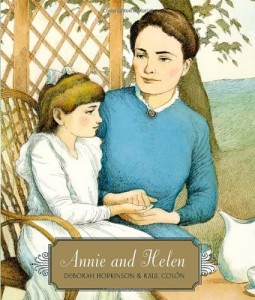 That’s certainly true with my new nonfiction picture book, Annie and Helen, illustrated by Raul Colon. Like most people I knew the general outlines of Helen Keller’s life, and I was familiar with the iconic moment at the water pump. But I knew very little of Annie Sullivan, or the details of her actual teaching methods. What I found was astonishing – so astonishing I wanted to share it with young readers.
That’s certainly true with my new nonfiction picture book, Annie and Helen, illustrated by Raul Colon. Like most people I knew the general outlines of Helen Keller’s life, and I was familiar with the iconic moment at the water pump. But I knew very little of Annie Sullivan, or the details of her actual teaching methods. What I found was astonishing – so astonishing I wanted to share it with young readers.
When I first began researching this book, I actually focused more on Annie Sullivan, whose early life was fraught with hardship. After her mother’s death, she and her little brother were put in an almshouse in Tewksbury, Massachusetts, where her brother later died. Annie, who’d become almost blind herself from trachoma, was able to go to the Perkins School for the Blind when she was 14. Operations partially restored her sight and she graduated in 1886 at the top of her class. The next spring, not quite 21, she set off alone from New England by train to take her first job: teaching a young deaf and blind child in Alabama named Helen Keller.
Annie Sullivan invented her own teaching methods, and that’s what I ultimately decided to write about in Annie and Helen. The book includes excerpts from Annie’s letters to her friend and former house mother, Mrs. Sophia Hopkins. The letters chronicle Helen’s progress and show how inventive and resourceful Annie was as she helped Helen make sense of the world through language. That spring must have been exhilarating for both teacher and student: by July, Helen had mastered enough skills to write a simple letter.
Annie and Helen is not a “cradle to grave biography.” Instead, it covers the period of March-July 1887, when teacher and pupil forged their incredible relationship. While I have written traditional biographies for very young readers on John Adams and Susan B. Anthony, and on Charles Darwin for slightly older readers, I often prefer to focus on a specific incident or a time period in order to illuminate someone’s life. Keep On! focuses on Matthew Henson’s early life and Arctic explorations, A Band of Angels is about Ella Sheppard’s experiences as a Jubilee Singer, and A Boy Called Dickens shows Dickens at age 12, when he was working in a blacking factory.
My books also include both nonfiction and historical fiction. My 2012 title, Titanic: Voices from the Disaster is nonfiction. But rather than write a biography of Dr. John Snow, the pioneering epidemiologist who proved that cholera was spread by water, I chose to fictionalize the story in my forthcoming middle grade novel, The Great Trouble, A Mystery of London, the Blue Death, and a Boy Called Eel. Hopefully readers will enjoy the story, and also there’s a long author’s note included if they want to know more.
I hope I will also be a reader who wants to know more. And perhaps that’s also a reason for choosing to write about Helen Keller. What better inspiration for the love of learning could there be?
To find out more about Deborah Hopkinson’s books, visit: www.deborahhopkinson.com
You can also discover more by following along on the Annie and Helen Blog Tour
September 1st: Watch. Connect. Read
September 1st: SharpRead
September 2nd: Nerdy Book Club
September 3rd: Bakers and Astronauts
September 4th: Two Writing Teachers
September 5th: Cracking the Cover
September 6th: Teach Mentor Texts
September 7th: Nonfiction Detectives
September 8th: Booking Mama
September 9th: Children’s Book Review
September 10th: Random Acts of Reading
September 11th: 7 Impossible Things Before Breakfast
Original article: Why Helen Keller? Selecting Subjects for Biographies
©2012 The Childrens Book Review. All Rights Reserved.
Add a CommentBlog: The Children's Book Review (Login to Add to MyJacketFlap)
JacketFlap tags: Writing Resources, Ages 4-8, Picture Books, Author Interviews, Adam Rex, Jon Klassen, Mac Barnett, featured, Add a tag
By Nicki Richesin, The Children’s Book Review
Published: September 7, 2012
Mac Barnett strikes us as kind of a mad genius. He’s published many bestselling books, founded the Echo Park Time Travel Mart, and is on the board of directors for 826 LA. While wearing these many top hats, he’s infused his delightfully offbeat sense of humor back into the land of children’s literature. It’s a pleasure to share his thoughts on some of his favorite books, time travel, his picture book manifesto, his undisputed rivalry with Adam Rex, and that remarkable sleuth Harriet the Spy with our readers.
Nicki Richesin: You got your start in children’s book publishing with the help of Jon Scieszka as your mentor. Did he offer you any words of wisdom or professional advice when you began writing?
Mac Barnett: I would never have written for kids if it weren’t for Jon’s books. They’re crowd-pleasing and smart, with intellectually rigorous underpinning that never gets in the way of belly-laughs. His and Lane Smith’s The Stinky Cheese Man and Other Fairly Stupid Tales is the most important children’s book of the last 30 years. I still send Jon all my work right after I finish it, and he’s given me a ton of guidance. As for words of wisdom, he’s always telling me to upgrade to United Economy Plus on tour, but I’m not sure my publishers will let me get away with that.
NR: Last year in The Horn Book, you issued (along with other authors and illustrators who co-signed) a proclamation in the form of “A Picture Book Manifesto” about the current state of children’s book publishing. What pushed you over the edge to write this manifesto and do you believe it has had the impact you intended? Had you hoped to inspire a sort of revolution?
MB: For a few years there’s been a lot of hand-wringing over the future of the picture book. The New York Times famously published a front-page article forecasting the form’s doom, and I’d heard similarly pessimistic prognoses from people inside the business. But the response to these Cassandras was too often Pollyannaish: variations on “The picture book will surely survive because the picture book is magic.” But picture books aren’t magic. Good picture books are magic. The proclamation represents a point of view I was hearing in my conversations with friends and colleagues but wasn’t seeing represented in either side of this Manichean conversation. I hope that it will continue to spark thoughtful discussion about the state of the art and its place in our culture, and also inspire people who want to make good picture books.
NR: You are on the board of directors of 826LA. Working with children in this way must be a great testing ground to try out new book ideas on your audience. Have you ever gotten any ideas from your students/fans you’d like to pursue writing one day?
MB: I’ve been working with kids ever since I wasn’t one anymore, and that’s had a giant impact on my writing. Picture books are a popular art and so it’s always been important for me to know my audience. But I don’t usually get ideas for books from kids’ suggestions. Mostly they just want me to write SpongeBob fan fiction. I give a presentation that shows students how a book is made—it’s filled with mainly useless information. After doing it for a year, a kid told me I should turn it into a book. He was right—Adam Rex is probably busy not illustrating it right now.
NR: You founded the Echo Park Time Travel Mart as a shopping destination for 826 products and accoutrements with the slogan, “whenever you are, we’re already then.” Could you tell us a bit about the genesis of the store? If you met at EPTTM and time-travelled to the Pirate store at 826 Valencia in San Francisco, would you be able to return or would you be forever marooned there?
MB: The Echo Park Time Travel Mart is the leading retailer of time travel supplies: dinosaur eggs, dodo chow, robot toupees—anything you’d need for a trip through the fifth dimension. The store fronts 826LA’s writing lab on the east side of L.A., and all the proceeds go toward the free tutoring we offer students in the neighborhood. The Mart has an online store, and we ship to destinations in the future, from a few days to many months after you’ve ordered, depending on the efficiency of the U.S. Postal Service. As for your question about getting marooned in San Francisco, you should be able to get back to LA as long as your time machine is functioning. We don’t really work on time machines at the Mart—we’re more like a 7-11: a bad place to get your car fixed, a good place to buy woolly mammoth chili.
 NR: Your first book with Adam Rex Guess Again was very unpredictable and amusing. I believe you’ve collaborated on six books together now (including your forthcoming Brixton Brothers installment). How do you find collaborating with Mr. Rex? Chloe and the Lion, the first story idea you had in college, is about a girl caught in the middle of a good-natured battle over artistic direction by the author (you) and illustrator (Adam Rex). After seeing your video for Chloe and the Lion, I was left wondering if Mr. Rex’s prima donna ways will prevent you from working together in the future.
NR: Your first book with Adam Rex Guess Again was very unpredictable and amusing. I believe you’ve collaborated on six books together now (including your forthcoming Brixton Brothers installment). How do you find collaborating with Mr. Rex? Chloe and the Lion, the first story idea you had in college, is about a girl caught in the middle of a good-natured battle over artistic direction by the author (you) and illustrator (Adam Rex). After seeing your video for Chloe and the Lion, I was left wondering if Mr. Rex’s prima donna ways will prevent you from working together in the future.
MB: We’ve actually done seven—our first collaboration was my very first picture book, Billy Twitters and His Blue Whale Problem. And I’ll tell you, working with him is a lot of work. I’m glad that you were able to see what a prima donna he is from that video—I was worried that a lot of his most outlandish behavior happened off-camera. Did you know that he made Disney provide a craft services table for what turned out to be a 15-minute shoot? And he requested four X-Boxes for his trailer. Adam doesn’t even play video games—they were just so he could sit on them and look taller.
NR: You edited “The Goods,” a McSweeney’s compendium of kids’ games, puzzles, comics and stories created by artists and writers for newspapers across the country. What do you see as your ultimate mission when delivering “The Goods”?
MB: The Goods, sadly, is now dead, or at least sleeping very deeply. But while it lasted, The Goods invited writers and artists to reimagine the kinds of activities you find (and used to find more) in the “Kids Pages” of newspapers. We featured pieces that were smart and beautifully illustrated, taking inspiration from the lavish stuff you find in the old Hearst and Pulitzer papers. Our timing was probably pretty bad: it turns out the newspaper business is going through a tough spot. But that’s all right. I’m working on my next business venture: going door-to-door selling dial-up modems.
NR: Which authors made the greatest impact on you when you were a young boy growing up in rural California?
MB: Well I was born in very rural California, but moved when I was still an infant to Castro Valley, which is in the Bay Area but weirdly maintains a rural vibe. I went to school in Oakland and so had zero friends in my hometown. I read a lot. James Marshall probably made my favorite books—I loved the Stupids. Let’s see, what else? The Monster at the End of this Book was very important to me, and also But No Elephants by Jerry Smath. My mom bought most of my books at garage sales, so I read a lot of literature from one or two generations before mine, and I feel very lucky for that.
 NR: I especially loved your book Extra Yarn as it told the story of a girl who didn’t really care what others thought and even went so far as to defy the dastardly, self-important duke. Were you inspired to write this book by a knitting feminist?
NR: I especially loved your book Extra Yarn as it told the story of a girl who didn’t really care what others thought and even went so far as to defy the dastardly, self-important duke. Were you inspired to write this book by a knitting feminist?
MB: Thank you! I was actually inspired by a drawing the book’s illustrator, Jon Klassen, had done of a girl and a dog wearing matching sweaters, walking through the snow. The story grew from that piece, (and in fact that moment actually shows up pretty early in the book, before all the bullies and archdukes arrive.)
NR: If you could be reincarnated as your favorite character from children’s literature, who would it be and why?
MB: My favorite character is probably Harriet M. Welsch—she’s perfectly, honestly drawn: funny and strong and flawed. Harriet has a pretty tough time, which is probably not preferable in the next life but is maybe karmically appropriate.
NR: Which projects are you currently working on and are there any stories you’re dying to tell?
MB: I just finished a strange new picture book I’m excited about and now I have to get into a novel that takes place in the desert.
Nicki Richesin is the editor of four anthologies The May Queen, Because I Love Her, What I Would Tell Her, and Crush. She is a regular contributor to Huffington Post, Daily Candy, 7×7, Red Tricycle, and San Francisco Book Review. Nicki has been reading to her daughter every day since she was born. For more information, visit: www.nickirichesin.com.
Original article: Interview with a Legend in his own Time Mac Barnett
©2012 The Childrens Book Review. All Rights Reserved.
Add a CommentBlog: The Bookshelf Muse (Login to Add to MyJacketFlap)
JacketFlap tags: writing resources, editing, lessons, characters, critique groups, writing groups, description, focus, guest entry, Add a tag
 When I found out the awesome and talented Melinda Collins was headed off to Colorado to attend Margie Lawson's Immersion Master Class, I absolutely had to convince her to swing by and tell us about the experience afterward. Of course, Writing Superhero Jami Gold had the same idea, so rather than stage an EPIC, lightning-sword-and-killer-unicorn BATTLE TO THE DEATH as to who got Melinda, we decided to share her. Isn't that nice? *beams*
When I found out the awesome and talented Melinda Collins was headed off to Colorado to attend Margie Lawson's Immersion Master Class, I absolutely had to convince her to swing by and tell us about the experience afterward. Of course, Writing Superhero Jami Gold had the same idea, so rather than stage an EPIC, lightning-sword-and-killer-unicorn BATTLE TO THE DEATH as to who got Melinda, we decided to share her. Isn't that nice? *beams*Immersion Master Class with Margie Lawson: The Experience, The Takeaways, The Lessons – Part Two
Thank you, Angela, for inviting me over today to talk about my recent experience in Colorado with the wonderful, talented, writerly genius, Margie Lawson, and her Immersion Master Class!
Because I have so much to share, this is actually a two-part blog post. Which means I’m also over at Jami Gold’s blog today as well with part one! *grin* And, as an added bonus, Margie Lawson will be over at my blog today, Muse, Rant, Rave, sharing even more writing technique goodies! *booty dance* Okay, enough dancin’ and let’s get to learnin’, shall we?
Over on Jami’s blog I talked about the kinship and sisterhood that developed in our group. Here I’d like to share with you two additional elements of the class that made this a one-of-a-kind experience.
The first would be location, location, location! We were about two miles above sea level, and being that high meant cell service was practically nonexistent, which in turn meant we got to enjoy the peace and quiet tranquility of the Rocky Mountains. What more inspiration do you need if you look outside the window, or go on a short hike and see this?
 |
| The view from our 1st hiking trip |
Pretty unreal, right? But this is exactly what every day was like for us. It wasn’t all work and no play. In fact, we went hiking twice during our time on the mountain. The first short hike gave us the beautiful view in the picture above, and the second, longer hike, gave us this gorgeous view:
 |
| The view from our 2nd hiking trip |
So the experience was deeper than just learning more about yourself and your writing craft. It was about taking the time to enjoy your surroundings and find inspiration in nature.
 |
| The view from Margie's writing loft |
The second element I wanted to share about the experience is the one on one time each of us got to spend with Margie. Every day, with pages in hand, we walked into a quiet, cozy room and worked one on one with Margie – an experience that will stay with me forever. By sitting down with her, one on one, you gain a certain understanding and perspective of your writing. You learn how to channel the genius editing that is her mind, and you see your writing in a whole new light. Every sentence, every word is purposefully chosen to pack a maximum punch for your reader, and during your one on one time, you learn more about how you choose those words and how you organize your sentences.
I can’t begin to imagine how I was editing before this class because now I feel as though I’m walking away with a particular sense of how to attack edits, how to look for the minor nuances, how to portray action scenes in a new and exciting way for the reader, and how to make my prose sing a beautifully cadenced tune.
The Takeaways
In part one I talk about what I learned about my style and where I want to be a year from now. Here I’d like to talk about group settings: why it’s important to work within a group where each person has the same purpose in their writing, and why it’s important to encourage and help other writers make their writing the best it can possibly be.
 |
| It's always important to take a break when editing to hike! ;) |
When you’re in a group setting and everyone has the same purpose of making their MS NYT Bestselling-worthy, you’re sitting in a gold mine. This is why it’s so incredibly important to join a writing group where everyone is dedicated and everyone pushes you to strive, work, and think harder. Sure, writing’s a singular experience (unless you’re co-writing), but without that group of writers who share your struggles, your doubts, and your triumphs, you may not get too far. This particular experience brought that fact home for me. When I struggled in making a phrase powerful and pitch-perfect, there were four other writers there tossing ideas back and forth until we got it. I’m sure without them there I might’ve gotten 85% of what I wanted in the phrase, but that’s not enough. I want 100%. I want it to pack a punch. And I want the help of other writers who fill in the gaps of my weaknesses.
This is another reason why it’s important to not only be in a group setting with a common purpose, but also to encourage other writers and their craft. We thrive on the encouragement and the kudos we get from others like us. We hear of another writer who’s just finaled
Individually, we are one drop. Together, we are an ocean. -- Ryunosuke Satoro
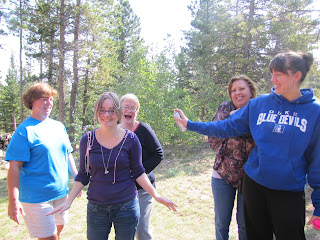 |
| I got the honor of silly-stringing Amanda! Sooo much fun!!! :) |
Quick note: While we were there, one of our Immersion Sisters, Amanda, actually did find out that she finaled in a writing contest with three scores of 99 out of 100!!!!! WOO HOO! How AWESOME is that?!? So what did we do to celebrate when we found out? We silly-stringed her of course!!!
The Lessons
Without giving away too much, here’s the back half of the top ten lessons I learned while in Colorado (as I said in the first post, there are many, many, many more):
1. Description: Description shouldn’t be on the page simply just to be there. Description should be on the page as it affects the character. When you’re writing description, think of how it affects your character in terms of their attitude and thoughts. If you had a character pull up to their childhood home, don’t just describe it as having paint-chipped shutters and a bright red door. Attach that description to your character. What does she remember about those shutters and that red door? Does she recall the many summers she spent helping her mother repaint the shutters? Does she recall being caught kissing a boy in front of the bright red door? If so, then why don’t you attach that description to those memories and make it a stronger, more powerful read?
Example from my MS:
I took a breath and walked out to the edge of the street. This house would represent the beginning of the rest of my life. I hadn’t seen the midnight blue, oceanfront home in so long, and it was now my home.
Because a home is a sense of trust, safety and love for my MC, I attached those feelings to the description of a place that is now her home. There’s more description of the house that follows this, but this is the one place where I purposefully showed how arriving to this setting affected my character.
2. Breaking Tension: Margie has an EDITS system that uses different colored highlighters to track story elements. One is tension. When you’re tracking tension and you notice a small – or big – area where you’ve broken the tension, you’d better go back to check the following:
a. Check to ensure you intended to break the tension.
b. Check to ensure the break in tension is not only needed, but that it works
c. Check to ensure it doesn’t entice the reader to skim
I’m willing to bet there may be several areas where you didn’t intend to break the tension, you didn’t intend to invite the reader to skim, you didn’t intend to put a humor hit in the middle of a serious scene that shouldn’t be broken.
So if you break tension, make sure it’s intentional, it works, it flows, and it doesn’t bore the reader in skipping ahead to where the tension picks back up.
3. NO ‘ITs’ or ‘THATs’: I now have yet another new item to add to my editing toolbox/checklist: NO ‘ITs’ or ‘THATs’!! Okay, so obviously I don’t mean you can’t have ‘it’ or ‘that’ in your MS as at all. But what I do mean is don’t end a sentence with ‘it’ or ‘that.’
Example:
Oh yeah, I’d considered that.
See what I mean? When I take this sentence out of context, you have absolutely no clue what the character meant by ‘that.’
Example without ‘that’:
Oh yeah, I’d considered Nick to be nothing more than an ant.
A-ha! So when I removed ‘that,’ I made the sentence stronger and more powerful! So the lesson here is: do a find for ‘IT’ and ‘THAT’ and restructure/reword each sentence/phrase that just so happens to end with one of those UNLESS having one of those two words 100%, unequivocally works!

4. Throw-Away Words (Tightening): Another important item to add to your editing checklist: throw-away words. This goes beyond the usual crutch words such as saw, felt, was, etc. Once of the techniques Margie teaches is taking a printed copy of your MS and reading through, line by line, and checking each line off to ensure it has a strong cadence. This ensures you don’t have any words in there that might trip the reader or the flow of the passage. As we all know, there are many other types of throw-away words that can tongue-tie the reader – which is another reason why it’s incredibly important that we get used to the sound of our voice, read everything aloud, and tighten, tighten, tighten.
Examples with Throw-Away Words:
After all, it wasn’t my fault their stories weren’t being told anymore.
I looked back at where he stood and touched my cheek.
Did I really need all those words? Nope.
Examples without Throw-Away Words:
It wasn’t my fault their stories weren’t being told anymore.
I touched my cheek.
See? I didn’t need after all and looked. Those were just two sentences! And between the two, I cut a total of nine words! By reading through my MS, line by line by line, and checking each one off once I’ve determined it’s a TEN, I will have a MS that’s tight, tight, tight! *booty dance*
5. Backloading: Ah… this is a fun one! But because there’s so much I could say about it and so little space in today’s post, I’m going to make it short and sweet. Backloading is where you take the most powerful word in a sentence, and you rework the phrase to pack that power at the end of the sentence so it resonates with the reader.
Example before Backloading:
And when we did see him, we never took a moment for granted, but that was before he abandoned us.
The most powerful word in this particular phrase is abandoned. When you hear it, you instantly feel for the character because you may know what it’s like to feel abandoned. So why not make it the last word the reader processes before they move to the next paragraph?
Example after Backloading:
And when we did see him, we never took a moment for granted. But that was before we were abandoned.
Not only did I ensure my power word was there to backload the phrase, I also split that large phrase into one semi-big sentence then followed it up with a shorter, powerful sentence.
Backloading forces you to look at the structure of your sentences and paragraph breaks. By examining each sentence with a finely-tuned, analytical eye, you’ll not only catch the instances where backloading will pack a punch, but you’ll also catch the areas where one larger sentence can be broken into two, shorter, more powerful sentences. Ha! I got two lessons into one on that one! *giggle*
Once again, I really, really, really want to encourage everyone to visit Margie’s site, purchase and read and absorb the lecture packets and/or enroll in an online course. After you’ve done that, I really recommend attending an Immersion Master Class yourself to fully learn not only these techniques/lessons, but waaaaay more! In all her courses, you’ll learn ways to add psychological power to your writing and how to write a page-turner that will keep your readers up until their spouse finally says, “Pleeeease come to bed!” *giggle*
Before I go, I just want to say thank you again to Angela for having me over today and allowing me to share a small percentage of what I learned!
If this was your first stop, then before you pop over to either Jami’s site for more on the experience, the takeaways and the lessons, or stop by my blog for a quick lesson from Margie, think about the following: Do you have a place you can get away to? One that’s quiet, calm and inspiring? What about a writing group – do you have a group of writers that you can learn from, give kudos to, and share your triumphs with? Do you have areas in your MS that could benefit from tying description to emotion? Or what about areas where you’ve broken the tension unintentionally? Do you run through each of your lines and ensure they work 100% before moving onto the next?
Wow! Thank you Melinda for being so generous and sharing your amazing experience with Margie! I am a life-long learner, and I absolutely love to absorb as much as I can about the writing craft. Margie's lecture packets are packed with great information and I am thrilled to be able to give one away. So, if you would like to win, just comment below and leave some contact information. THEN, visit Jami for another chance to win a lecture packet and Melinda's for a crack at an online course with Margie! This is the BERMUDA TRIANGLE OF WIN, people!
Good luck & happy writing!
Blog: The Bookshelf Muse (Login to Add to MyJacketFlap)
JacketFlap tags: writing resources, lessons, characters, emotion, guest post, Add a tag
I am triple-fudge-sundae excited to welcome Martha Alderson (aka The PLOT WHISPERER) to The Bookshelf Muse as she sends The Plot Whisperer Workbook: Step-by-Step Exercises to Help You Create Compelling Stories
Here's Martha on the Benefits of Plotting in Scenes!
Some writers write by the seat of their pants. Others prefer to pre-plot first, write after. Some write and plot, write and plot, write and plot. Eventually, every writer who sticks with her writing achieves a draft or a partial made up of scenes. The leap from the generative stage of writing scenes to the analytical stage of analyzing what you have written often leave writers frozen or in a tangled heap.
Analyze Your Plot by Scenes
In a scene a character acts and reacts to people, places, and events. In this respect, scenes are the basic building blocks of your story. But, as with any structure, if you have the wrong scenes or if they’re assembled incorrectly, your story can—unexpectedly—collapse.
Before you can create a visual map for analyzing critical story information, presentation flow, and the overall story sequence, you have to have scenes. Likely, you have heard the writer’s mantra: “Show, don’t tell.” Summary tells. Scenes show.
I use the following partial scene from the middle-grade Newbery Medal-winning novel Holes by Louis Sachar, an example for analyzing a scene from my workbook.
Stanley Yelnats has been unjustly sent to a boys’ detention center where the boys build character by spending all day, every day, digging holes exactly five feet wide and five feet deep.
Scenes that Show Emotion
This scene, as do all good scenes, shows moment-to-moment action in real story time. The reader experiences the work as Stanley does it and learns about the protagonist, not because the author tells us but because he shows us through Stanley’s actions. We learn the protagonist is overweight and can laugh at himself. We learn he has staying power because rather than give up and suffer the consequences he finds a way to break the earth open. We learn he is bright in that he quickly realizes his mistake in dumping the dirt within the perimeter of his hole and immediately rectifies the situation.
The details of Stanley jumping on the back of the shovel blade with both feet, leaning on the shaft, measuring the hole, and taking a drink from his canteen draw the reader into the moment of the scene. The reader attaches viscerally to the fleeting happiness Stanley feels at being heavy enough to sink the shovel a few inches into the packed earth, his despondency when he understands how wide five feet actually is, his momentary success in prying up his first shovelful, and his disappointment in counting “only ten million more to go”––not to mention his despair when he acknowledges the full magnitude of the task in front of him.
Create a List of Scenes
A partial list of scenes from the beginning of the award-winning middle grade novel Esperanza Rising by Pam Munoz Ryan is an example used in the companion Plot Whisperer Workbook.
The novel is set during the time of the American Great Depression and is about a young Mexican girl, who’s sense of self is stripped when she and her mother are forced to leave their life of privilege in Mexico for an uncertain future in the United States as farm workers.
In analyzing Esperanza Rising, create a list of the novel’s scenes (we only went a couple of scenes past the one-quarter mark and into the middle of the story). For your exercise, list your scenes all the way to the end of your story. Shorten scene titles while still capturing the major plot elements of the scene. Each scene title should take up no more than one line of the following scene list.
It’s not necessary for you to have written all (or any) of your scenes. Just list scene ideas in the order in which you envision them landing in your story. If your book is made up of many small chapters, each one encapsulating a scene, list events in the story by chapter.
The trick to this exercise is not to see how many scenes you can list. Instead, you want to identify and list scenes that advance the story on a multitude of plot levels.
Remember that it may take you several tries before you get the list in an order that satisfies you. For this reason, I recommend using a pencil instead of a pen, so you can erase parts of your first ordering and move scenes around. Also remember that it’s often a good idea to try out this exercise using scenes from a favorite book. The more you practice this analysis and construction, the better you’ll get at it.
– a companion workbook to The Plot Whisperer: Secrets of Story Structure Any Writer Can Master
As the founder of Blockbuster Plots for Writers and December, International Plot Writing Month, Martha manages an award-winning blog for writers, awarded by Writers Digest 2009, 2010, 2011, 2012. Her vlog, How Do I Plot a Novel, Memoir, Screenplay covers 27 steps to plotting your story from beginning to end. Find her on Twitter, and if you like, add her workbook to your Goodreads list!
Would you like to take your writing to the next level with Martha's intuitive Plot Whisperer Workbook? This giveaway is open internationally, so just leave a comment with some contact info and share if you plot your scenes already, or if this is a technique you'd like to try. As always, tweets and shares are greatly appreciated. Good luck, everyone!
Blog: Emmasaries (Login to Add to MyJacketFlap)
JacketFlap tags: childrens books, plot, series, writing for children, writers resources, book series, storyboard, plot structure, writing a series, plot sequence, Blog, writing resources, Add a tag
 When it comes to maintaining continuity of plot details in a series, it can be helpful to create a scene chart or a storyboard for each story as well as for the overall series itself.
When it comes to maintaining continuity of plot details in a series, it can be helpful to create a scene chart or a storyboard for each story as well as for the overall series itself.
Some novelists use index cards or Post-it notes to build a storyboard, because they allow for manipulation of the sequence of events in quick and immediately visible ways – but for tracking the many elements of a series over several books, a spreadsheet may be a better choice.
Whichever method you choose, the elements to consider keeping track of include:
- Book Number / Title
- Chapter Number / Title
- Scene Number
- Time / Time Frame
- Location / Setting
- Characters
- Central Problem/ Conflict
- Action / Events
- Surprises / New Information
- Open Questions
The last item is particularly important when it comes to avoiding red herrings and tying up loose ends. Make note of any questions, puzzles or mysteries that come up in the course of a chapter so that you can track when, where and how they get resolved.
Of course tracking plot details for continuity is different than crafting a plot in the first place – but keeping a record of the myriad details can be helpful when it comes to plot development and the editing/revision process. On the Children’s Book Hub, we have spreadsheets for both crafting plot and tracking the details, but you can create your own by copying and pasting the above elements into headings on a spreadsheet.
Next up, continuity of voice…
Blog: The Children's Book Review (Login to Add to MyJacketFlap)
JacketFlap tags: featured, Bonny Becker, Animal Books, Mouse and Bear Series, Writing Resources, Ages 4-8, Author Interviews, Add a tag
By Nicki Richesin, The Children’s Book Review
Published: April 11, 2012
Award-winning author Bonny Becker is probably best known for the sensation she created with her Mouse and Bear book series. A prolific writer who has had many jobs over the years, including advising aspiring authors, she found her niche in writing for children. They have truly fallen in love with her stories. Listen in as we discuss her inspiration for her characters, the secret to writing an exceptional story, and even Dorothy from The Wizard of Oz!
Nicki Richesin: Thank you for taking time to chat with TCBR. You have become an outrageous success with your Mouse and Bear book series. Bear seems to be a bear of simple tastes and Mouse is a little more cunning. How did these characters first appear to you?
Bonny Becker: Mouse came first. Literally popping into my head as I was musing about how things keep coming back into your life until you face them and deal with them. Being a writer that somehow transformed itself into this metaphor—a mouse who wouldn’t go away. I immediately liked my little mouse and set about thinking of whom he could annoy. The first creatures to flash through my mind were an elephant and a lion for obvious reasons. I briefly considered a human character. But as soon as I thought of a bear I knew I’d found my perfect victim.
 NR: In past interviews, you’ve said that Mouse represents the problem that won’t go away and keeps popping up in one’s life. You said some people seem to have the same problem show up again and again in their lives, like a bad boss or a bad boyfriend. Mouse is such a lovable character despite being a metaphor for problems you’d like to rid your friends and family of. He makes you love him! How did you make a pest so lovable?
NR: In past interviews, you’ve said that Mouse represents the problem that won’t go away and keeps popping up in one’s life. You said some people seem to have the same problem show up again and again in their lives, like a bad boss or a bad boyfriend. Mouse is such a lovable character despite being a metaphor for problems you’d like to rid your friends and family of. He makes you love him! How did you make a pest so lovable?
BB: Well, supposedly, life will keep sending you the same problem until you solve it with some change in yourself. You know, like not recognizing that you always get attracted to the same type of guy and it never works out. On the other hand, Mouse is rather like that perfect boyfriend that life sends your way and you just need to see it! In Bear’s case, what Mouse brings to Bear is the part of Bear that is joyful and full of life. What I like about Mouse is he’s willing to put himself out there and remains cheerful in spite of all setbacks. He just knows that Bear is worth knowing!
NR: W
Add a CommentBlog: The Children's Book Review (Login to Add to MyJacketFlap)
JacketFlap tags: Writing Resources, Ages 4-8, Ages 9-12, Picture Books, Yuyi Morales, Author Interviews, featured, Books for Girls, David Diaz, Billie Holiday, Women's History, Lisa Congdon, Amy Novesky, Georgia O’Keeffe, Cultural Wisdom, Frida Kahalo, Add a tag
By Nicki Richesin, The Children’s Book Review
Published: March 21, 2012
Amy Novesky is the author of Elephant Prince; Me, Frida and most recently Georgia in Hawaii. A former editor at Chronicle Books, Novesky brings years of experience to her work as both a children’s book editor and author. She teaches writing workshops to aspiring authors and is co-founder of Ever After Studio, a children’s book production company and the creative director of Paper Hat Press, a company that creates customizable children’s book and keepsakes. She discussed her research on Georgia O’Keeffe (in Hawaii) and Billie Holiday and Imogen Cunningham for her forthcoming books Mister and Lady Day and Imogen.
Nicki Richesin: Congratulations on the publication of Georgia in Hawaii! When I think of Georgia O’Keeffe, I tend to think of her hiking on Ghost Ranch. What inspired you to tell this story of her trip to Hawaii?
 Amy Novesky: I think most people think of Georgia that way, and there are some beautiful picture books that tell that story. But few people know that Georgia painted in Hawaii, and that’s exactly why I wrote this book. Imagine this painter famous for painting flowers and landscapes, painting in the most beautiful flower-filled landscape of all. I also wrote this book because I have a connection to Hawaii, and if there was any Georgia book I was going to write, it was this one.
Amy Novesky: I think most people think of Georgia that way, and there are some beautiful picture books that tell that story. But few people know that Georgia painted in Hawaii, and that’s exactly why I wrote this book. Imagine this painter famous for painting flowers and landscapes, painting in the most beautiful flower-filled landscape of all. I also wrote this book because I have a connection to Hawaii, and if there was any Georgia book I was going to write, it was this one.
NR: March is Women’s History Month and you have published wonderful books on truly remarkable women like Frida Kahlo and Georgia O’Keeffe and even more coming soon. What do you look for in a person’s life to make you want to tell his or her story and how do you find the hook that will appeal to a broad audience of readers?
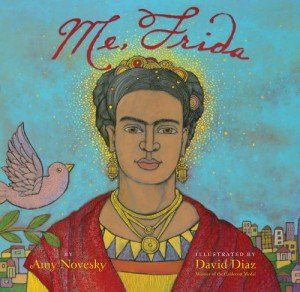 AN: Most stories start with the art. I am drawn to the art. Often, though, I’m drawn as much, if not more, to the artist. For example, I knew I wanted to write stories about both Frida Kahlo and Billie Holiday, but with each I didn’t want to tell the typical narrative. And then, too, especially with Frida and Billie, I had the added challenge of finding a story that was kid-friendly, given how tragic both of their lives were. (Frida had polio as a child and was in a horrific accident as a young adult; Billie was a child prostitute an
AN: Most stories start with the art. I am drawn to the art. Often, though, I’m drawn as much, if not more, to the artist. For example, I knew I wanted to write stories about both Frida Kahlo and Billie Holiday, but with each I didn’t want to tell the typical narrative. And then, too, especially with Frida and Billie, I had the added challenge of finding a story that was kid-friendly, given how tragic both of their lives were. (Frida had polio as a child and was in a horrific accident as a young adult; Billie was a child prostitute an
Blog: Stories. Read'em. Write'em. (Login to Add to MyJacketFlap)
JacketFlap tags: Writing resources, Add a tag
Anna Myers, author of nineteen books for young people and recipient of multiple awards, and Pati Hailey, author of the 2011 Sue Alexander runner up, Finding Tru, have teamed up to offer a unique opportunity to aspiring writers. The Critique Cafe at Heron House can really help you bring your writing to the next level. Imagine spending the weekend in a peaceful and welcoming setting, with two wonderful writers who will teach you, answer questions, and offer support. Both Anna and Pati are natural teachers.
Pati has developed focused visualizations which will help you connect with your characters and see, hear, smell, feel, and taste the scenes in your book.
They offer three different types of retreat - Idea Development, Manuscript Review - Basic Elements, and Full Manuscript Review. Each retreat includes secluded writing time away from the distractions of day to day life, mentoring, education and feedback.
One word of warning. This experience is for those who want to stretch and improve as writers, not for those who want to be told they're already great. These two ladies will give you honest critiques. I should know. I myself have cried at Heron House, but my manuscript is much the better for it.
For more information, check out the website at www.critique cafe.net
Blog: The Children's Book Review (Login to Add to MyJacketFlap)
JacketFlap tags: Writing Resources, Illustrator Interviews, featured, Pam Allyn, World Read Aloud Day, Lindsey Manwell, Add a tag
By Nicki Richesin, The Children’s Book Review
Published: March 4, 2012
Lindsey Manwell is a gifted illustrator and painter. She’s also the illustrator-in-residence for LitWorld. In her awe-inspiring blog A Year in Paris, she chronicles her year abroad living with her newlywed husband in Paris. To celebrate World Read Aloud Day this March 7, Lindsey agreed to speak with TCBR about her work with LitWorld, her determined path to publication, and the beauty and grandeur of Paris.
Nicki Richesin: I’m so excited to interview you as we met on World Read Aloud Day through the efforts of LitWorld- a cause I know that is near and dear to your heart. Could you tell us how you became the illustrator-in-residence for LitWorld and a little bit about the organization?
Lindsey Manwell: Sure! In 2009 I went to a literary event in Mill Valley where Pam Allyn was guest speaking. Pam is one of the leading literacy experts in the world. I met her before she took the stage and in those few brief moments we really connected. When she spoke that night I learned a lot about how many people in the US and abroad cannot read. It sounds naïve, but I was very shocked. Growing up my mom was an English teacher, so literacy and books were a way of life that I guess I took for granted. Afterwards we stayed in touch, and just a couple months later I was proudly illustrating a logo and putting together a coloring book for LitWorld that would travel the globe helping people learn how to read. Ever since then I’ve joyfully taken on various work for LitWorld year-round.
In one sentence, LitWorld teaches training techniques that help cultivate and sustain literacy in places around the world. It’s funny because the day I met Pam in Mill Valley I felt right away that we were kindred sprits who had to work together, and now I laugh as after 3 years of working with her I’ve learned that pretty much everyone who meets her- from the big wigs in New York City to the 5 year olds in Kenya- all feel this way!
NR: Congratulations on signing your two book series deal with HarperCollins! You are illustrating two upcoming books and you also work as a realist oil painter. I’m sure you must be thrilled to see your dreams coming true. Could you share your road to publication and any words of advice for aspiring illustrators?
LM: Absolutely. My road to publication has been rocky and it’s taken me over two years to get my first contract. When I graduated from art school I went straight to New York to meet with publishers, portfolio in hand. Within a few months I was con
Add a CommentBlog: The Children's Book Review (Login to Add to MyJacketFlap)
JacketFlap tags: Writing Resources, Ages 9-12, Chapter Books, Author Interviews, Books for Girls, Kate Klimo, Centaurs, Fantasy: Supernatural Fiction, Teens: Young Adults, Add a tag
By Kate Klimo, The Children’s Book Review
Published: February 27, 2012
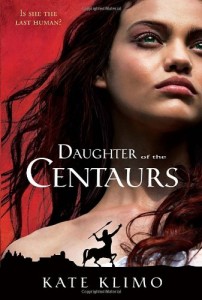 Kate Klimo talks about character development for “Centauriad: Daughters of the Centaurs“ (Random House Books for Young Readers, 2012), the first book in her new series.
Kate Klimo talks about character development for “Centauriad: Daughters of the Centaurs“ (Random House Books for Young Readers, 2012), the first book in her new series.
What’s in a Centaur’s Pocket?
How does a centaur dress? How does a centaur go to the bathroom? What do a centaur’s home furnishings look like? What do centaurs eat? And what is it like to inhabit a body that is half-horse? These are just some of the scads of questions for which I had to know the answers before I could even sit down to write Daughter of the Centaurs. The inimitable Martin Scorsese says that you have to know what is in your characters’ pockets before you can put them on the screen. Well, I had to figure out whether centaurs even had pockets before I could fill them and then put them on the page. Where to even start?
Doing research for a fantasy novel is a tricky business. After all, it isn’t our world. But it does need to have a certain internal logic, which is to say that it needs to make sense within its own context. Being a fantasy writer is a little like being a god of the Deist school. You devise the World Machine—with all its spinning wheels and cogs and gears—and then you wind it up and see if it works. The first order of business was to research centaurs in myth. This, I told myself, might provide me with some crucial cogs and gears, if not the whole machine.
Centaurs are a manifestation of the human psyche and imagination that first showed itself in the days of antiquity. I read about Chiron, the wise centaur who taught Hippocrates—Father of Modern Medicine—the healing arts. So far so good. But then all the other centaurs I went on to read about were pretty much a pack of bloodthirsty louts, the offspring of Ixion and Nelphele. They were also thought to be the children of Centaurus who mated with the Magnesian Mares. This tribe of composite horse and human dwelled in Magnesia and Mount Pelion in Thessaly and on the Malean Penninsula.
The central story in myth starring centaurs cast them as arch villains, as lawless gang members who crashed a wedding of the Lapithians, who were actually the centaurs’ human cousins. The centaurs ran off with the Lapithian bride and all of the female guests. Those centaurs all had names. There is a long list of them. There are females listed but female centaurs aren’t featured in the Wedding Crashers story; nor are they pictured in any of the sculptures depicting centaurs until much later in history. As far as I could make out, the centaurs represented the lower appetites at war with civilized behavior.
This gave me the idea of creating a highly civilized centaurean society that, by the time the central action of Daughter of the Centaurs opens, has risen above its base nature and learned to control its animal appetites. It had done so through the teachings of a wise centaur named Kheiron (a bow to the Chiron of myth.) When Kheiron first came among the centaurs they were so murderous that they had, in fact, wiped out one of the last human cities and occupied it. Kheiron had taken these lawless louts in hand and preached to them the virtues of vegetarianism, temperance, and non-violence. Some of the centaurs rejected the teachings of Kheiron and ran off to pursue their lawless ways (these “Wild Centaurs” make their appearance in the second book of the trilogy, The Backbone of Heaven
Add a CommentView Next 25 Posts



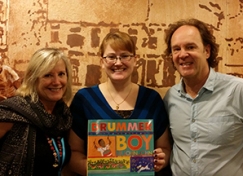
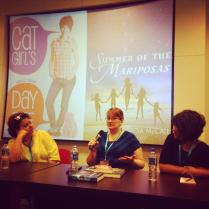

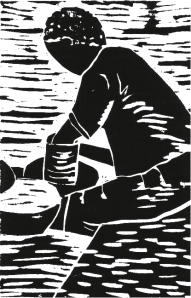
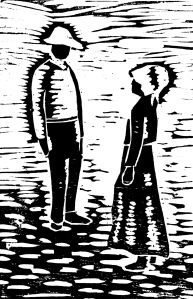


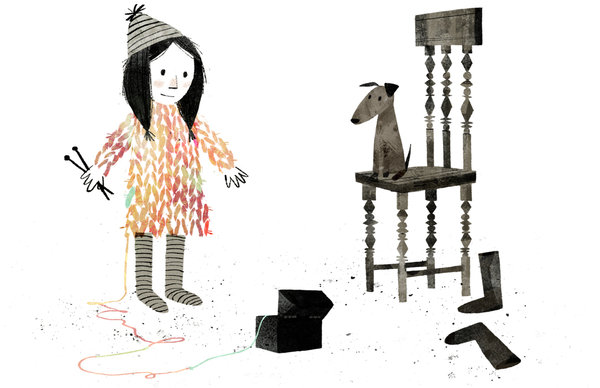








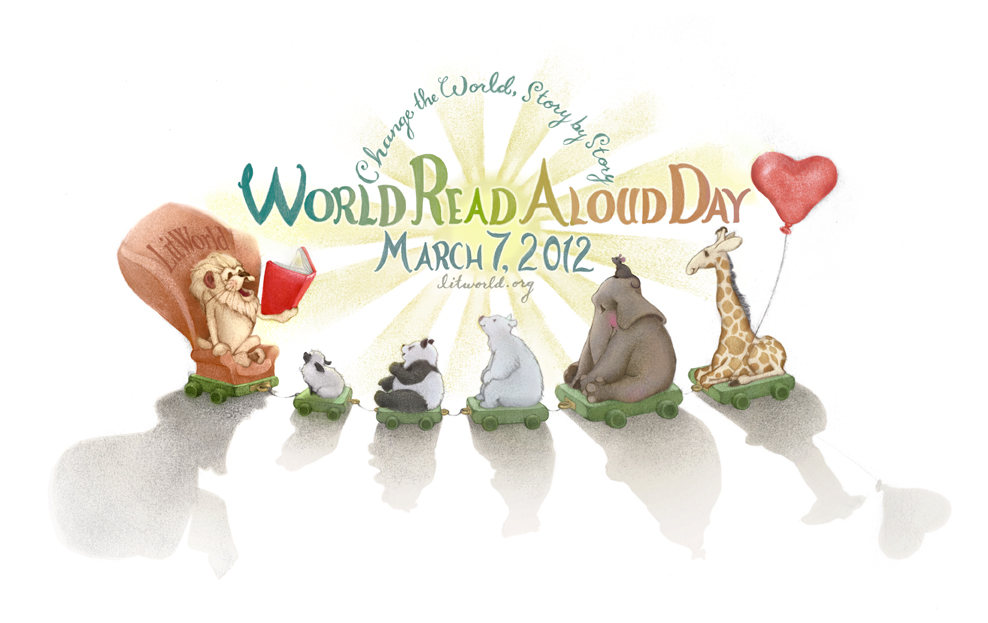
All too often, showing the bad guy’s point-of-view just gives away too much. I’ve seen it done well, mind you, but most stories gain tension from not knowing what the bad guy’s ultimate motives or end game will be. Sure you can try to keep the scene really short to avoid revealing too much, but in the end, the writer has to maintain too great a distance between the reader and the villain’s thoughts that it’s near impossible to get any emotional investment. Using a subordinate to the villain for the scene’s point-of-view can sometimes work to maintain the villain’s mystique while revealing critical plot points which will add to the tension, since they likely won’t know what their superior’s true plans really are.
All that said, I would politely disagree with Moore about how evil works. I’m sorry, but I firmly believe some people are evil. It has nothing to do with good intentions gone wrong. Do they see themselves as evil? Probably not, but that doesn’t mean they were ever working with good intent. Some people simply enjoy the suffering of others or are incapable of considering the welfare of other people. That doesn’t excuse the writer from providing depth to their villains, and most of the people who are truly “crazy evil” lack enough discipline to be some kind of mastermind. They’re just raging bulls, which make for poor villains in most stories.
I agree with you, Bill, that it gives away too much, and perhaps a lot of my boredom with these POVs is that they distance the reader from the POV for obvious reasons.
However, re: evil, I would contend that most writers (TV, book, and movie) don’t understand how mental illness works, so we have a cultural narrative that crazy=evil and evil=crazy. Which creates a stigma against mental illness, and a misunderstanding of how evil begins (like Hitler-level evil, to break Godwin’s Law, but I think it’s relevant to this discussion). Most evil in the world, I would agree, is because some people enjoy the suffering of others (or are too selfish to care or notice that they’re causing it). However, I would posit that most of those people got to where they are in their evil-ness by making choices over time, not being born that way or being just plain crazy/mentally ill.
In storytelling, it’s my opinion that we need to get away from the one-dimensional villain–the villain who is evil because he is crazy/demented.
I think you’re right that it depends on the villain. If the villain is interesting and motivated and “the hero of her own story” then reading the villain is going to be every bit as fascinating as reading the hero. I love the idea of the Maleficent movie, for example — of understanding the circumstances that would lead to her cursing a baby.
I wrote villain POV for the first time in my latest book, and I loved it. It made me love her much more and what made her tick. She was a smart, hard working woman, and she believed she was righting a wrong, even though it hurt a lot of people.
And I loved it so much that the last two stories I wrote were from the villain’s POV. One was a retelling of Sleeping Beauty, in fact and one was from the POV of the one of the villains in my killer unicorn series.
I also love “redemption of a villain” stories, which of course have quite a long history. The Bible, for example, is full of them!
I think you’re right that it depends on the villain. If the villain is interesting and motivated and “the hero of her own story” then reading the villain is going to be every bit as fascinating as reading the hero. I love the idea of the Maleficent movie, for example — of understanding the circumstances that would lead to her cursing a baby.
I wrote villain POV for the first time in my latest book, and I loved it. It made me love her much more and what made her tick. She was a smart, hard working woman, and she believed she was righting a wrong, even though it hurt a lot of people.
And I loved it so much that the last two stories I wrote were from the villain’s POV. One was a retelling of Sleeping Beauty, in fact and one was from the POV of the one of the villains in my killer unicorn series.
I also love “redemption of a villain” stories, which of course have quite a long history. The Bible, for example, is full of them!